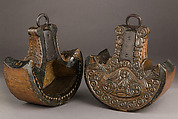Pair of Stirrups
Not on view
These large, heavy, and elaborate Mapuche stirrups may have been used for rituals and ceremonies in which horses were adorned with richly adorned tack. Their general shape draws inspiration from Argentinian campana stirrups, which evolved from 18th-century European types.
The carved geometric designs refer to Mapuche symbolism and cosmogony. The circle with the cross represents meli witran mapu (literally the land of the four places), the four parts of the world. The circles with a central dot, on the lower rim, may be representations of the sun or stars and the crown-shaped symbols may represent the head of Lukutuwe, or the First Man, as he appears on many Mapuche textiles. Hearts and leaf-shaped motifs are other traditional designs, while the four pointed mounts at each corner of the stirrup represent sacred spaces and communication with deities.
The Mapuches are indigenous inhabitants of present-day south-central Chile and southwestern Argentina. Mapuches were fierce warriors, never defeated by the Incas or Spanish, and the Mapuche lands were conquered only in 1883. They adopted the horse for war very shortly after their first encounter with the Spanish in 1551, and before the end of the century they had several organized squadrons of cavalry. The animal then soon became an important part of traditional Mapuche life.
Due to rights restrictions, this image cannot be enlarged, viewed at full screen, or downloaded.

